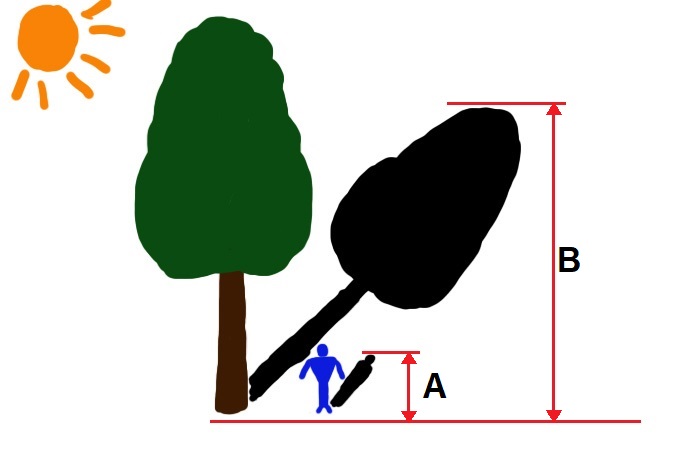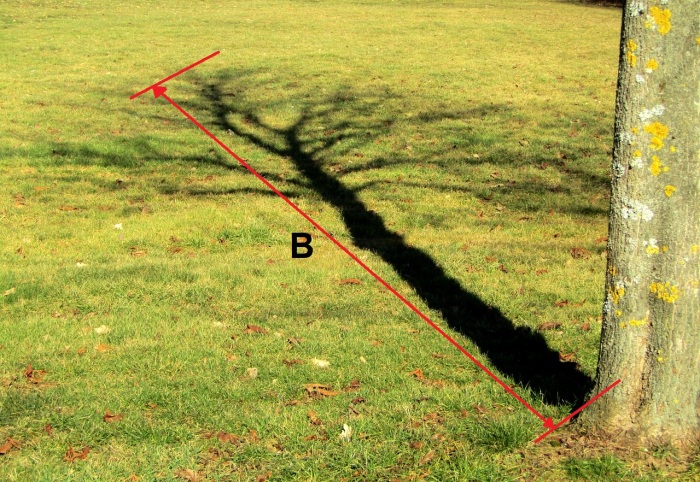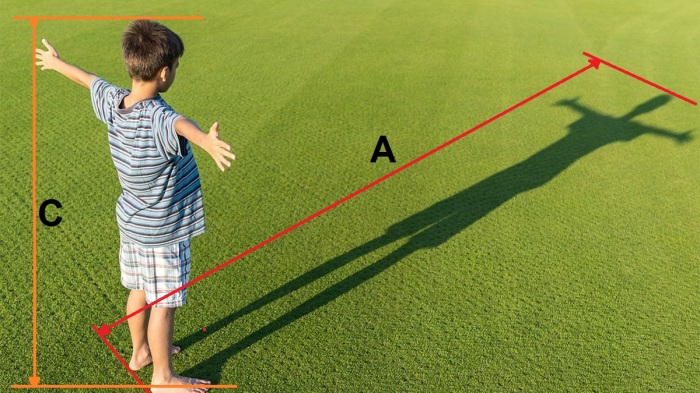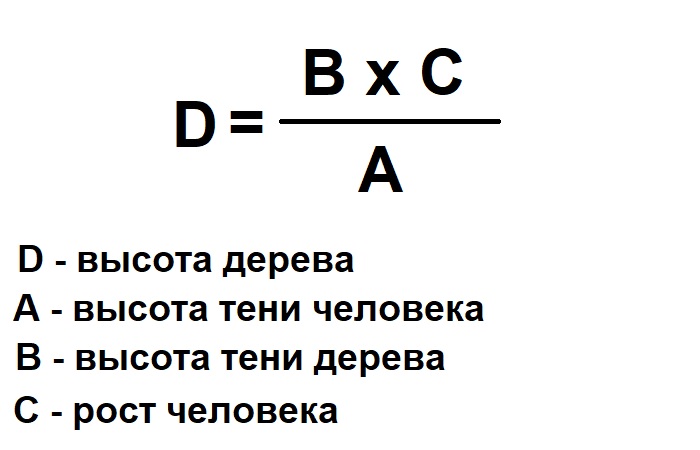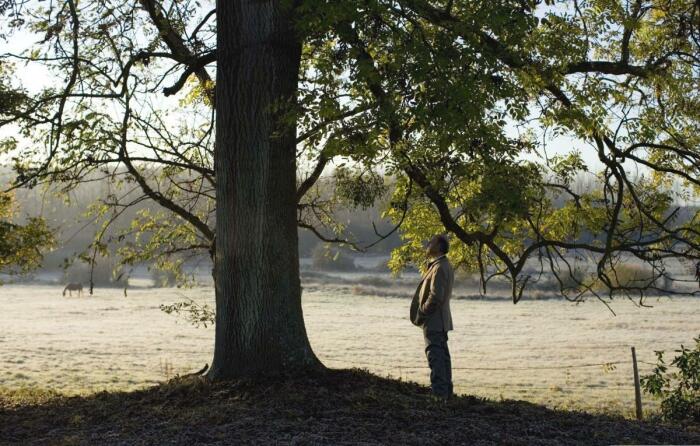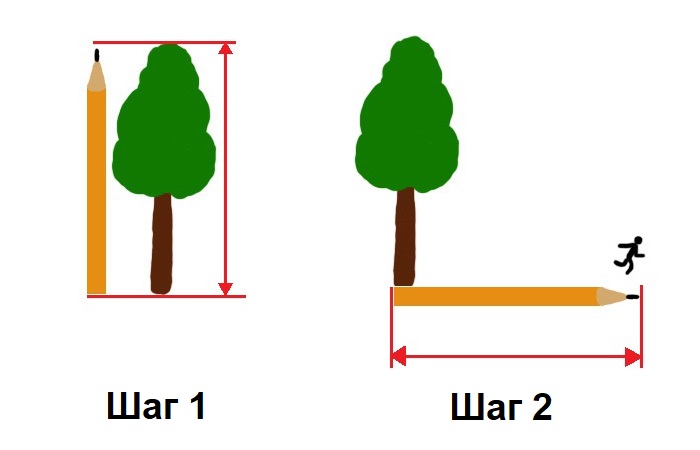-
-
November 15 2020, 14:00
- Природа
- Cancel
Два способа, как измерить высоту дерева, не забираясь на него
Никогда не знаешь, что именно пригодится завтра! Человек должен стараться овладеть как можно большим количеством разнообразных навыков. Некоторые из тех, что на первый взгляд кажутся абсолютно бесполезными, могут сыграть решающую роль в какой-нибудь жизненной ситуации, пригодившись самым неожиданным образом.
Например, мало кто знает, как можно легко и быстро измерять высоту дерева.
Метод первый – при помощи тени
Самый простой способ измерять дерево – это использовать его и свою тень. Для этого нужно встать рядом с растением и сначала отметить место, где оказались пятки, а потом отметить место до которого падала твоя тень. Полученный отрезок необходимо измерять. После этого необходимо снять мерку с тени дерева.
Два важных момента. Первый – тень должна лежать на ровной земле без уклона, в противном случае полученные данные не будут объективными и не помогут получить правильное значение. Второй – измерять тень себя-любимого и коварного дерева нужно в одно и то же время.
Когда все мерки будут сняты, то дело останется за малым – математическими подсчетами. Для этого умножаем длину тени дерева на высоту своего роста и полученное значение делим на высоту своей тени. Полученное значение и будет высотой дерева.
Метод второй – при помощи карандаша
Измерять высоту дерева можно еще и при помощи карандаша. Помимо пишущей принадлежности для работы понадобится еще один (а лучше два) человека. Первым делом следует взять карандаш в руку и стать таким образом, чтобы дерево было видно целиком от корней до макушки. Рядом со стволом дерева ставится человек-помощник.
Сжимаем карандаш в кулаке и вытягиваем его перед собой, прищуриваем один глаз и соотносим кончик грифеля с макушкой растения. Подвигаем ноготь большого пальца так, чтобы он оказался под основанием ствола. Далее поворачиваем кулак на 90 градусов, чтобы карандаш сал параллелен земле.
После этого человеку, стоящему у ствола, дается команда идти вдоль карандаша от дерева. Как только его силуэт достигнет грифеля, следует дать команду остановится. В итоге расстояние от ствола дерева до твоего товарища и будет высотой растения.
В полевых условиях иногда бывает очень важно и полезно владеть простейшими прикладными способами измерений на местности. Например способами определения высоты дерева или любого другого предмета на местности.
Простые способы определения высоты дерева или любого другого предмета по тени, шесту, лужице или зеркалу, прямоугольному треугольнику.
Высоту дерева или любого другого предмета на местности очень просто можно определить по тени, шесту, лужице или зеркальцу, и прямоугольному треугольнику.
Способ определения высоты дерева или другого предмета по своему росту и длине тени.
Если на ровном месте измерить шагами длину своей тени, а затем длину тени, отбрасываемой деревом илипредметом, то искомую высоту легко вычислить из пропорции :
АК/ак = КЕ/ке
где АК — высота дерева (В), КЕ — тень дерева (D), ак — ваш рост (b), ке — ваша тень (d).
Например длина вашей тени d равна трем шагам, тень дерева D равна девяти шагам, то есть тень дерева длиннее вашей тени в три раза. Если принять ваш рост за 1,5 метра, то высота дерева будет В = 1,5 х 3 = 4,5 метра.
Способ определения высоты дерева или другого предмета по шесту и своему росту.
Этот же способ можно применить при пасмурной погоде, когда тени от предметов не видны. В этом случае для измерения нужно взятьшест, равный длине вашего роста. Шест этот надо установить на таком расстоянии от дерева, чтобы лежа можно было видеть верхушку дерева на одной прямой линии с верхней точкой шеста. Тогда высота дерева равна расстоянию от вашей головы до основания дерева, то есть АС = ВС.
Способ определения высоты дерева или другого предмета по лужице или зеркальцу.
По лужице, зеркальцу илигелиографу высоту дерева или любого другого предмета на местности, можно измерять следующим образом. Станьте так, чтобы лужица поместилась между вами и деревом (В). Найдите точку, из которой видна отраженная в воде вершина дерева. Измеряемоедерево будет во столько раз выше вас, во сколько расстояние от него до лужицы (ВО) больше расстояния от лужицы до вас (АО). Вместо лужицы также можно воспользоваться зеркальцем, положив его горизонтально так, чтобы увидеть вершину дерева.
Способ определения высоты дерева или другого предмета с помощью прямоугольного треугольника с двумя острыми углами по 45 градусов.
С помощью прямоугольного треугольника с двумя острыми углами по 45 градусов, высоту дерева или другогопредмета определяют так. Отходя от дерева на некоторое расстояние и прикладывая треугольник к глазам так, чтобы один из его катетов был параллелен оси дерева, второй — параллелен земной поверхности, а гипотенуза представляла собой линию визирования.
Затем добиваются такого положения, чтобы линия визирования прошла через вершину дерева. В этом случае высота дерева D равна расстоянию от наблюдателя до дерева и плюс рост наблюдателя.
По материалам книги «Карта и компас мои друзья».
Клименко А.И.
Можно для измерения высоты дерева использовать законы подобия треугольников.
Втыкаем вертикально палку или шест в землю. Измеряем рулеткой длину шеста и его тени.
Принимаем величину шеста, например, за h, а длину тени, которую он отбрасывает за s. После этого измеряем величину тени от дерева, допустим это будет H. Из закона подобия треугольников следует, что H относится к h как S относится к s, где H та высота дерева, которую нужно узнать.
Остаётся только подставить измеренные значения в формулу H = h*S/s.
Надо только следить, чтобы палка стояла строго вертикально и не допускать погрешности в измерениях.
Download Article
Download Article
At a secret location somewhere in northern California, a tree named Hyperion has been measured at a world record height of 379.3 feet (115.61m)![1]
Believe it or not, the measurement was made with an extra-long tape measure, but there are much easier methods you can try yourself. While you won’t be accurate to the exact inch or centimetre, these methods will give you a good approximation, and works on any tall object. Telephone poles, buildings, or magic beanstalks: as long as you can see the top, you can measure it.
Choose a Method
- Piece of paper: No math or other tools necessary!
- Shadows: Requires a tape measure, flat ground, visible shadows, and basic arithmetic.
- Pencil: A quick but rough estimate using a pencil and a friend.
- Clinometer or tools: These are the most accurate tools. You can build a clinometer yourself out of basic school supplies.
-
1
Use this method to find the height of a tree without doing any math. All you need for this method is a piece of paper and a tape measure. No calculations are necessary; however, if you’re interested in how this works, you might need to know a little trigonometry.[2]
- The method Using a Clinometer or Transit goes into the full calculations and reasons why this work, but you don’t need to go into it to find the height using this method.
-
2
Fold a piece of paper in half so that it forms a triangle. If the paper is rectangular (not square), you’ll have to make a rectangular sheet of paper into a square. Fold one corner over so it forms a triangle with the opposite side, then cut off the extra paper above the triangle. You should be left with the triangle you need.
- The triangle will have one right (90 degree) angle and two 45 degree angles.
Advertisement
-
3
Hold the triangle in front of one eye by holding a corner opposite from the 90º right angle (see the above picture), and point the rest of the triangle toward you. One of the short sides should be horizontal (flat), and the other should be vertical (pointing straight up). You should be able to look up along the longest side by raising your eyes.[3]
- The longest side, the one you’ll be looking along, is called the hypotenuse of the triangle.
-
4
Move back from the tree until you can sight the top of the tree at the top tip of the triangle. Close one eye and use the other to look directly along the longest side of the triangle, until you see the exact top of the tree. You want to find the point where your line of sight follows the longest side of the triangle to the very top of the tree.[4]
-
5
Mark this spot and measure the distance from it to the base of the tree. This distance is almost the full height of the tree. Add your own height to this, since you were looking at the tree from the height of your eyes off the ground. Now you have the full answer![5]
- To learn how this works, see the «Using a Clinometer or Transit» section. You don’t need to do any calculations in this method, because there’s a little trick: the tangent of a 45º angle (which you used) equals 1. The equation can be simplified to this: (Height of tree) / (distance from tree) = 1. Multiple each side by (distance from tree) and you get: Height of tree = distance from tree.
Advertisement
-
1
Use this method if you only have a tape measure or ruler. You don’t need any other equipment to use this method, and you should get an accurate estimate of how tall the tree is. You will need to do multiplication and division problems, but no other math.[6]
- If you want to avoid doing any math at all, you can use a tree height calculator online, such as this one, and enter the measurements you find using this method.
-
2
Measure your height. Use a tape measure or yardstick (meter ruler) to measure your height while standing straight. Do this while wearing the shoes you will be wearing to perform this method. Since you’ll need a piece of paper anyway, write your height down so you don’t forget the exact number.
- You’ll need a single number, such as your height in inches, not a combination of feet and inches. If you’re not sure how to convert into one number, you can use the height of a yardstick or meter ruler standing vertical instead (3 feet or 1 meter). Use the ruler’s height and the length of the ruler’s shadow anytime you are asked to use
- If you are in a wheelchair or cannot stand straight for another reason, measure your height in whatever position you’ll be in when you go outside to measure the tree.
-
3
Stand on sunny, flat ground near the tree. Try to find a spot where your shadow falls along flat ground so you can get an accurate measurement. For best results, do this method on a bright, sunny day. If the sky is overcast, it may be difficult to precisely measure the shadows.
-
4
Measure the length of your shadow. Use a tape measure or yardstick (meter ruler) to measure the distance from your heels to the tip of your shadow. If you don’t have someone to assist you, you can mark the end of the shadow by tossing a rock onto it while you’re standing. Or better yet, place the rock anywhere on the ground, and then position yourself so the tip of your shadow is at the rock; then measure from where you’re standing to the rock.[7]
- Write down and label each measurement you make right after you make it, to avoid confusing them with each other.
-
5
Measure the length of the tree’s shadow. Use your measuring tape to determine the length of the tree’s shadow from the base of the tree to the tip of the shadow. This works best if the ground all along the shadow is fairly level; if the tree is on a slope, for example, your measurement won’t be as accurate. Do this immediately after you’ve measured your shadow, since the sun’s movement will cause the shadow length to change.[8]
- If the tree’s shadow is on a slope, there might be a different time of day when the shadow avoids the slope either by being shorter or by pointing in the other direction.
-
6
Add 1/2 the tree’s width to the length of the tree’s shadow. Most trees grow straight upwards, so the highest tip of the tree should be above the exact middle of the tree. To get the total length of its shadow, you should add 1/2 the diameter of the tree trunk to your shadow measurement.[9]
This is because the highest tip is actually causing a longer shadow than you measured; some of it is just falling over the top of the tree trunk where you can’t see it.- Measure the width of the trunk with a long ruler or straight tape measure, then divide by 2 to get 1/2 the tree’s width. If you’re having trouble seeing how wide the trunk is, draw a tight square around the base of the trunk and measure one side of that square.
-
7
Calculate the tree’s height using the numbers you wrote down. You should now have three numbers written down: your height, your shadow’s length, and the length of the tree’s shadow (including 1/2 its trunk width). Shadow lengths are proportional to the height of the object. In other words, (your shadow’s length) divided by (your height) will always equal (the tree’s shadow’s length) divided by (the tree’s height). We can use this equation to find out the tree’s height:[10]
- Multiply the length of the tree’s shadow by your height. If you are 5 feet (1.5 meters) tall, and the tree’s shadow is 100 feet (30.48 meters) long, multiple them together: 5 x 100 = 500 (or for the meter measurements, 1.5 x 30.48 = 45.72).
- Divide the answer by the length of your shadow. Using the example above, if your shadow is 8 feet (2.4 meters) long, divide your answer by that number. 500 / 8 = 62.5 feet (or in metric, 45.72 / 2.4 = 19.05 meters).
- If you’re having trouble with the math, find a tree height calculator online such as this one.
Advertisement
-
1
Use this method as an alternative to the shadow method. While this method is less accurate, you can use it when the shadow method won’t work, such as on an overcast day. Also, if you have a tape measure with you, you can avoid having to do math. Otherwise, you’ll need to find a tape measure later and do some simple multiplication problems.[11]
-
2
Stand far enough from the tree so you can view the whole tree—top to bottom—without moving your head. For the most accurate measurement, you should stand so that you are on a piece of ground that is about level with the ground at the tree’s base, not higher or lower. Your view of the tree should be as unobstructed as possible.
-
3
Hold a pencil at arm’s length. You can use any small, straight object, such as a paint stick or ruler. Hold it in one hand and stretch your arm out so that the pencil is at arm’s length in front of you (between you and the tree).
-
4
Close one eye and adjust the pencil up or down so that you can sight the very top of the tree at the top of the pencil. This is easiest if you turn the pencil so that the sharpened point is pointing straight up. The tip of the pencil should thus just cover the top of the tree in your line of sight as you look at the tree “through” the pencil.
-
5
Move your thumb up or down the pencil so that the tip of your thumbnail is aligned with the tree’s base. While holding the pencil in position so that the tip is aligned with the tree’s top (as in step 3), move your thumb to the point on the pencil that covers the point (again, as you look “through” the pencil with one eye) where the tree meets the ground. Now the pencil is «covering» the entire height of the tree, from the base to the tip.[12]
-
6
Rotate your arm so that the pencil is horizontal (parallel to the ground). Keep your arm held straight out at the same distance, and make sure your thumbnail is still aligned with the tree’s base. The thumb should be even with the center of the bottom of the tree.
-
7
Have your friend move so that you can sight him or her “through” the point of your pencil. That is, your friend’s feet should be aligned with the pencil’s tip. He or she should be about the same distance from you as the tree is, not further away or closer toward you. Since, depending on the height of the tree, you may need to be some distance away from your friend, consider using hand signals (with the hand that is not holding the pencil) to tell him or her to go farther, come closer, or move to the left or right.[13]
-
8
If you have a tape measure with you, measure the distance between your friend and the tree. Have your friend remain in the place or mark the spot with a stick or rock. Then use a measuring tape to measure the distance between that spot and the base of the tree. The distance between your friend and the tree is the height of the tree.[14]
-
9
If you don’t have a tape measure with you, mark the height of your friend and the height of the tree on the pencil. Scratch or draw a mark on the pencil where your thumbnail is; this is how long the tree appears from your perspective. Use the same method as before to arrange the pencil so it covers your friend, with the tip at your friend’s head and your thumbnail at his or her feet. Make a second mark at this position of your thumbnail.
-
10
Find the answer once you have access to a tape measure. You’ll need to measure the length of each mark and the height of your friend, but you can do this after you go home, without having to return to the tree. Scale the difference in lengths on the pencil up to your friend’s height. For instance, if the mark showing your friend’s height is 2 inches (5 cm) from the tip and the mark for the tree’s height is 7 inches (17.5 cm), then the tree is 3.5 times as tall as your friend, since 7 inches / 2 inches = 3.5 (17.5 cm / 5 cm = 3.5). If your friend is 6 feet (180 cm) tall, the tree is 6 x 3.5 = 21 feet tall (180 cm x 3.5 = 630 cm).
- Note: If you do have a tape measure with you when you’re near the tree, you do not need to do any calculations. Read the step above for «if you have a tape measure» carefully.
Advertisement
-
1
Use this method to get a more accurate measurement. The other methods are surprisingly accurate, but with a little more math and specialized tools you can get a more accurate reading. It’s not as daunting as it sounds: all you need is a calculator that can calculate tangents, and a cheap plastic protractor, straw, and piece of string so you can Make a Clinometer yourself. A clinometer measures the slope of objects, or in this case the angle between you and the top of the tree. A transit is a more complicated tool used for the same purpose, but uses a telescope or laser to achieve more accuracy.[15]
- The Piece of Paper method actually uses a piece of paper as a clinometer. This method, besides being more accurate, allows you to measure the height from any distance, instead of moving forward and backward to get the paper to line up with the tree.
-
2
Measure the distance to a sighting position. Stand with your back to the tree and walk out to a point that is approximately level with the ground at the tree’s base and from which you can clearly see the tree’s top. Walk in a straight line, and use a measuring tape to measure your distance from the tree. You need not stand any set distance from the tree, but this method generally works best if your distance from the tree is about 1-1.5 times the height of the tree.[16]
-
3
Measure the angle of elevation to the tree’s top. Sight the top of the tree and use a clinometer or transit to measure the «angle of elevation» between the tree and the ground. The angle of elevation is the angle formed between two lines—the flat plane of the ground and your sight line, to some elevated point (in this case, the tree’s top) — with you as the vertex of the angle.[17]
-
4
Find the tangent of the angle of elevation. You can find the tangent of an angle using a calculator or table of trigonometric functions. The method for finding the tangent may differ depending on your calculator, but usually you just push the “TAN” button, enter the angle, and then press the “equal” button (=). Thus if the angle of elevation is 60 degrees, you simply push “TAN” and then enter “60” and then press the equal sign.[18]
- Click this link to go to an online tangent calculator.
- The tangent of an angle in a right triangle is defined by the side opposite the angle, divided by the side adjacent to the angle. In this case, the opposite side is the height of the tree, and the adjacent side is your distance from the tree.
-
5
Multiply your distance from the tree by the tangent of the angle of elevation. Remember, you measured your distance from the tree at the beginning of this method. Multiply it by the tangent you calculated. The resulting number tells you how high the tree is above your eye level, since that’s the level you calculated the tangent from.[19]
- If you read the earlier substep about the definition of the tangent, you can see why this method works. As described earlier, the tangent = (tree’s height) / (distance to tree). Multiply each side of the equation by the (distance to tree) and you get (tangent) x (distance to tree) = (the tree’s height)!
-
6
Add your height to the height you calculated in the previous step. Now you have the height of the tree. Since you used the clinometer or transit at eye level, not ground level, add your height to the measurement to get the total height of the tree. You can get a more accurate result by measuring your height at eye level, not to the top of your head.[20]
- If you are using a stationary transit, add the height from the transit eyepiece to the ground, not your own height.
Advertisement
Add New Question
-
Question
What is the importance of measuring the tree?
Somebody felling a tree would need this to determine if the tree might hit anything, such as a house, as it falls down. The height of the tree would become the damage radius.
-
Question
Why do I measure the shadow of the tree, why not just measure the tree itself?
The shadow is typically on the ground (unless it falls on a building, other trees, etc.), and it’s much easier to measure a thirty foot shadow rather than taking a ladder and actually measuring the tree. Besides, the tree-tops would make it hard to measure accurately, since the leaves on most trees are always moving a little bit.
-
Question
Which is longer, a lunar month or a sidereal month?
Lunar, because it takes about 29 and a half days. A sidereal takes about 27 days.
See more answers
Ask a Question
200 characters left
Include your email address to get a message when this question is answered.
Submit
Advertisement
-
You can improve the accuracy of the pencil method and the angle of elevation methods by taking several measurements from different points around the tree.
-
Many trees are not perfectly vertical—they don’t grow straight up. Using the angle of elevation methods you can adjust for an angled tree by measuring the distance between you and the point on the ground that lies directly below the tree’s top, rather than measuring the distance between you and the base of the tree.
-
This can be a fun activity for 4th to 7th grade kids.
Show More Tips
Thanks for submitting a tip for review!
Advertisement
-
These methods do not work well if the tree is on sloping ground. A professional surveyor uses electronic transits in these situations, but these are typically too expensive for home use.
-
While the angle of elevation methods, if used correctly, can calculate the correct height within 2-3 feet, there is abundant opportunity for human error, especially if the tree is angled or on a slope. If precision is absolutely necessary, consult your local extension service or other such agency for assistance.
Advertisement
Things You’ll Need
- A friend (optional for most methods, but a little help makes the process easier and more fun)
-
either a tape measure or yardstick (meter ruler)
-
or a clinometer or transit
-
or a piece of paper
-
plus a pencil (for one method)
References
About This Article
Article SummaryX
The easiest way to measure the height of a tree is to fold a piece of paper in half so it forms a right triangle. Then, hold the triangle so one point faces your eye while the right angle and other point face the tree. Next, back up until the two points of the triangle and the top of the tree are all in line. Finally, use a tape measure to find the distance between where you’re standing and the tree, and add your height to that distance. To learn how to use a clinometer to measure the height of a tree, read on!
Did this summary help you?
Thanks to all authors for creating a page that has been read 1,146,699 times.
Reader Success Stories
-
«We are learning about the emergent layer of the rain forest in homeschool. My daughter wondered how people measure…» more
Did this article help you?
Определение размеров по тени и своему росту.
Высоту предметов
можно определить по тени нужного
предмета, по своему росту. Для определения
высоты предмета по его тени необходимо
поставить в тени этого предмета (к
примеру, дерева) палку недалеко от его
верхушки и измерить длину части палки,
покрытой тенью. Тогда ВБ :АБ=ДГ :АГ, откуда
ДГ=АГ(ВБ : АБ), т. е., разделив длину покрытой
тенью части палки на расстояние от нее
до верхушки тени дерева и помножив это
число на длину тени, получим высоту
предмета (дерева). Высота предмета по
своему росту определяется следующим
образом. Необходимо отойти от дерева
на известное расстояние АД, лечь головой
к точке А и ногами, между которыми зажата
палка, к дереву в точке В так, чтобы наш
луч зрения проходил через верх палки
на вершину дерева. Тогда 5Д=ЛДХ Х( СВ-АВ).
Определение расстояния по эталонам.
Расстояние можно
определить с помощью эталонов — точных
мер. Эталонами могут быть разные части
человеческого тела, данные измерений
разных предметов, имеющих стандартные
размеры:
1. 10 см — длина
указательного пальца у взрослого
человека. Для измерения его необходимо
согнуть под прямым углом к ладони. Если
же палец короче 10 см, то его длину
необходимо записать и запомнить. В
походе это понадобится;
2. 10 см — расстояние
между свободно разведенными концами
мизинца и большого пальца, когда рука
без напряжения лежит на планшете;
3. высота человека с
поднятой рукой, если кисть руки отогнуть
назад;
4. высота от пола до
пояса человека;
5. расстояние между
кончиками пальцев рук в положении «руки
в стороны» у большинства людей равняется
росту;
6. средняя длина шага
взрослого человека равняется приблизительно
половине его роста при измерении до
уровня глаз. Практически установлено,
что длину своего шага можно определить
по формуле: Р/4 +37, где Р — рост человека
в сантиметрах; 4 и 37 — постоянные числа.
Например: при росте 120 см длина шага
будет равна — 120/4 +37=30+37=67 см.
7. Расстояние от глаза
до основания указательного пальца
вытянутой руки равняется 57 — 60 см. Этой
величиной можно пользоваться для
нахождения величины любого угла.
Известно, что на указанном расстоянии
каждый сантиметр имеет угловую величину
1°. Поскольку длина указательного пальца
равна 10 см, то достаточно согнуть его в
основании под прямым углом к линии всей
руки и измеритель готов: между концом
указательного пальца и его основой, т.
е. изгибом, образуется угол 10°. Определение
величины любого угла в градусах делается
следующим образом: согнутый под прямым
углом у основания указательный палец
на вытянутой руке устанавливается на
уровне глаз. Смотреть надо одним глазом,
лучше правым, и держать голову прямо,
все время в одном положении. После этого
начинают укладывать свою мерку по
прямой, соединяющей два предмета, между
которыми определяется угол. Совместив
конец пальца с одним из предметов,
следует отметить, против чего находится
другой конец пальца. Это и будет 10°.
Затем, перемещая палец по прямой и
совмещая его конец с отмеченным местом,
напротив которого был перед этим изгиб
пальца, находим новое место изгиба — тут
оканчиваются следующие 10°. Это уже 20°
от начала. И так нужно дойти до второго
предмета, который ограничивает угол.
Вполне возможно, что он ляжет где-то
посредине пальца. В этом случае важно
на глаз определить, сколько десятых
частей пальца будет между его концом и
визированным предметом. Это число целых
градусов надо будет прибавить к измеренным
перед этим десяткам градусов. Например,
палец уложен целиком 3 раза, после чего
осталось еще 4/10 его длины. Значит, два
предмета лежат под углом 2Г». Выполняя
эту работу, нельзя менять положение
руки относительно корпуса тела и глаза.
Необходимо вслед за пальцем медленно
поворачиваться корпусом.
8. От конца большого
пальца до конца мизинца, если держать
вытянутую руку прямо на уровне глаза и
перпендикулярно к направлению зрения,
— 22,5°. Этой мерой можно пользоваться для
измерения больших углов (от 45°).
Указанные выше
соотношения между частями человеческого
тела приблизительные и приведены как
постоянные величины для человека
среднего роста. У детей и подростков
даже одного возраста эти величины
неодинаковые, поскольку это связано с
ростом и индивидуальными особенностями.
Поэтому желательно, чтобы каждый турист,
готовясь в поход, определил и записал
свои мерки. Эталонами могут служить и
такие предметы, которые имеют постоянные
стандартные размеры (саперная лопатка,
туристский топорик, спичечный коробок,
карандаш, монета). Эти предметы туристы
всегда имеют при себе, и ими всегда можно
воспользоваться. В зависимости от района
путешествия южных туристов можно самому
составить таблицу расстояний по степени
видимости характерных для этого района
местных предметов.
Соседние файлы в предмете [НЕСОРТИРОВАННОЕ]
- #
- #
- #
- #
- #
- #
- #
- #
- #
- #
- #


